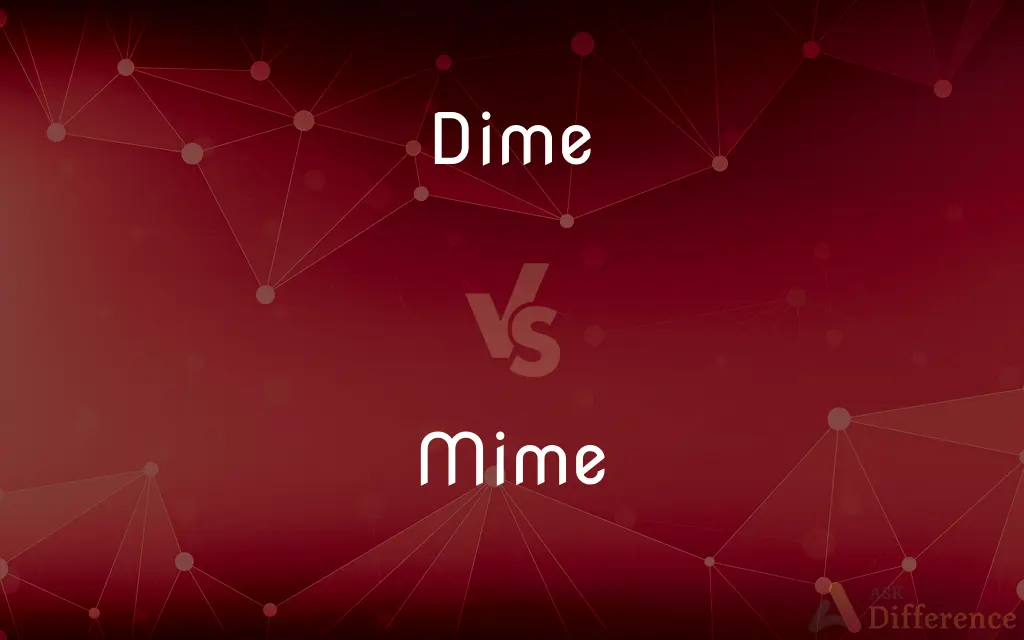Dime vs. Mime — What's the Difference?
By Tayyaba Rehman — Updated on September 27, 2023
"Dime is a U.S. coin worth ten cents, e.g., He gave a dime for charity. Mime is a performance art involving silent acting or imitating, e.g., He excels in mime, depicting scenes without words."

Difference Between Dime and Mime
Table of Contents
ADVERTISEMENT
Key Differences
Dime and Mime are two words with entirely different meanings, applications, and categories in English. A Dime is a coin in the United States currency, valued at ten cents, a tenth of a dollar. It is a common unit of currency used in everyday transactions, signifying a specific monetary value. Its main application is in the realm of commerce and trade, facilitating buying and selling.
In contrast, Mime refers to a form of performing art where actions, emotions, and situations are conveyed without the use of words or speech. This art form is based on physical movement, gestures, and expressions to communicate a narrative or concept. It’s a mode of expression, often seen in theaters and street performances, where artists depict characters and tell stories through body language.
The word Dime is primarily used as a noun, denoting a specific object with a monetary value. It is tangible and quantifiable, often used in financial contexts to represent a unit of currency. It's part of everyday language, especially in discussions related to money, prices, and transactions.
On the other hand, Mime can function as both a noun and a verb, representing either the art form itself or the act of performing mimed actions. Mime is associated with the realm of performing arts, focused on visual portrayal and physical expression. It is more about conveying messages, emotions, and narratives through silent performances and bodily movements.
To summarize, Dime and Mime belong to completely different categories; one is a tangible representation of monetary value, and the other is an intangible form of expressive, silent art. While a Dime is an everyday object used in monetary transactions, Mime is a skillful, artistic expression that communicates without using words.
ADVERTISEMENT
Comparison Chart
Category
Currency
Performing Art
Use
Monetary Transactions
Expressing narratives without words
Function
Represents value
Conveys emotions and situations
Form
Tangible, physical object
Intangible, form of expression
Part of Speech
Noun
Noun, Verb
Compare with Definitions
Dime
A monetary unit equal to one-tenth of a dollar.
He paid a dime for the candy.
Mime
A theatrical performance using gestures and actions without words.
The mime depicted a man trapped in a box.
Dime
Slang for assisting or informing, typically to law enforcement.
He dropped a dime on his accomplices.
Mime
To imitate actions and gestures silently to convey a story.
He can mime the entire scene perfectly.
Dime
A piece of U.S. currency used in everyday transactions.
Could you lend me a dime?
Mime
An actor performing in silence using body movements.
The mime entertained the crowd with his antics.
Dime
A U.S. coin worth ten cents.
She found a dime on the sidewalk.
Mime
A form of expression using body language without speech.
Mime is a powerful way to convey emotions.
Dime
A coin of the United States or Canada worth ten cents.
Mime
To represent or imitate actions without using sound.
She can mime the emotions beautifully.
Dime
(US) A coin worth one-tenth of a U.S. dollar.
Mime
A communications protocol that allows for the transmission of data in many forms, such as audio, binary, or video.
Dime
(Canada) A coin worth one-tenth of a Canadian dollar.
Mime
A form of ancient Greek and Roman theatrical entertainment in which familiar characters and situations were farcically portrayed on stage, often with coarse dialogue and ludicrous actions.
Dime
(North America) A small amount of money.
She didn't spend a dime.
Mime
A performance of or dialogue for such an entertainment.
Dime
An assist.
Mime
A performer in a mime.
Dime
(slang) A playing card with the rank of ten.
Mime
A modern performer who specializes in comic mimicry.
Dime
(slang) Ten dollars.
Mime
The art of portraying characters and acting out situations or a narrative by gestures and body movement without the use of words; pantomime.
Dime
(slang) A thousand dollars.
Mime
A performance of pantomime.
Dime
(slang) A measurement of illicit drugs (usually marijuana) sold in ten dollar bags.
Mime
An actor or actress skilled in pantomime.
Dime
(slang) A ten year prison sentence.
Mime
To ridicule by imitation; mimic.
Dime
(slang) Payment responsibility.
Are you traveling on the company's dime?
Mime
To act out with gestures and body movement.
Dime
A beautiful woman (10 on a 10-point scale).
Mime
To act as a mimic.
Dime
(American football) A defensive formation with six defensive backs, one of whom is a dimeback.
Mime
To portray characters and situations by gesture and body movement.
Dime
To inform on, to turn in to the authorities, to rat on, especially anonymously.
Somebody dimed on me and I got arrested for selling marijuana.
Mime
A form of acting without words; pantomime.
Dime
To operate an audio amplifier (especially an electric guitar amplifier) at level "10" (typically the highest amplification level).
I get the best-sounding sustain and smooth harmonic distortion when I run the amp dimed.
Mime
A pantomime actor.
Dime
A silver coin of the United States, of the value of ten cents; the tenth of a dollar.
Mime
A classical theatrical entertainment in the form of farce.
Dime
A United States coin worth one tenth of a dollar
Mime
A performer of such a farce.
Dime
Street name for a packet of illegal drugs that is sold for ten dollars
Mime
A person who mimics others in a comical manner.
Dime
Representing a small amount of money.
He sold the book for a dime.
Mime
Any of various papilionid butterflies of the genus Chilasa or Papilio, that mimic other species in appearance.
Mime
A unit of imitation in the theory of symbiosism.
Mime
To mimic.
Mime
(intransitive) To act without words.
Mime
To represent an action or object through gesture, without the use of sound.
In this game, you're given a word, which you have to mime to the others in the group.
Mime
A kind of drama in which real persons and events were generally represented in a ridiculous manner; an ancient Greek or Roman form of farce.
Mime
An actor in such representations.
Mime
The art of representing actions, events, situations, or stories solely by gestures and body movements, without speaking; pantomime{3}.
Mime
An actor who performs or specializes in mime{3}; an actor who communicates entirely by gesture and facial expression; a pantomime{2}; a pantomimist; a mimer.
Mime
A mimic.
Mime
To mimic.
Mime
An actor who communicates entirely by gesture and facial expression
Mime
A performance using gestures and body movements without words
Mime
Imitate (a person, a manner, etc.), especially for satirical effect;
The actor mimicked the President very accurately
Mime
Act out without words but with gestures and bodily movements only;
The acting students mimed eating an apple
Common Curiosities
Is Mime a form of theatrical art?
Absolutely, Mime is a form of performing art using gestures and body language without words.
Does a Mime use words in their performance?
No, a Mime conveys narratives through silent gestures and actions.
Is a Dime tangible?
Yes, a Dime is a tangible object, representing monetary value.
Can Mime be used to depict various emotions and situations?
Yes, Mime artistically depicts a range of emotions and situations through silent expressions and gestures.
Is a Dime a form of U.S. currency?
Yes, a Dime is a coin in U.S. currency worth ten cents.
Can Dime also refer to a small amount of money in informal language?
Yes, in informal language, Dime can refer to a small amount of money.
Is Dime used daily in financial transactions?
Yes, a Dime is commonly used in everyday financial transactions in the U.S.
Is Mime effective in conveying narratives without speech?
Absolutely, Mime effectively conveys narratives and emotions through silent actions and expressions.
Can Mime be both a noun and a verb?
Yes, Mime can refer to the art form (noun) or the act of miming (verb).
Does the word Dime only represent a specific amount in U.S. currency?
Typically yes, a Dime specifically represents ten cents in U.S. currency.
Share Your Discovery

Previous Comparison
Petticoat vs. Crinoline
Next Comparison
Blast vs. ExplodeAuthor Spotlight
Written by
Tayyaba RehmanTayyaba Rehman is a distinguished writer, currently serving as a primary contributor to askdifference.com. As a researcher in semantics and etymology, Tayyaba's passion for the complexity of languages and their distinctions has found a perfect home on the platform. Tayyaba delves into the intricacies of language, distinguishing between commonly confused words and phrases, thereby providing clarity for readers worldwide.















































